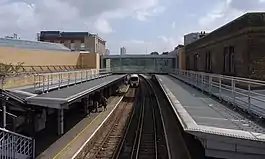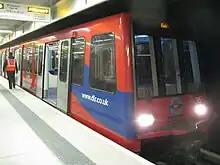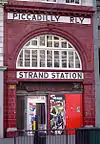| Woolwich Arsenal | |
|---|---|
 | |
 Woolwich Arsenal Location of Woolwich Arsenal in Greater London | |
| Location | Woolwich |
| Local authority | Royal Borough of Greenwich |
| Managed by | Southeastern |
| Station code | WWA |
| DfT category | C2 |
| Number of platforms | 4 (2 underground platforms served by DLR) |
| Accessible | Yes[1][2] |
| Fare zone | 4 |
| OSI | Woolwich |
| DLR annual boardings and alightings | |
| 2018 | |
| 2019 | |
| 2020 | |
| 2021 | |
| 2022 | |
| National Rail annual entry and exit | |
| 2018–19 | |
| 2019–20 | |
| 2020–21 | |
| 2021–22 | |
| 2022–23 | |
| Key dates | |
| 1 November 1849 | Opened |
| 12 January 2009 | DLR opened |
| Other information | |
| External links | |
| WGS84 | 51°29′24″N 0°04′08″E / 51.490°N 0.069°E |
Woolwich Arsenal station is a National Rail and Docklands Light Railway (DLR) paired interchange station in the heart of Woolwich in the Royal Borough of Greenwich. It has two parts; its raised, south-western part of the station is on the semi-slow, commuter service, corollary of the North Kent Line and also in its Dartford Loop services section between London and Dartford, run by Southeastern. Regular services beyond Dartford are to the Medway Towns, which start/finish in the opposite direction at Luton via the City of London, West Hampstead and St Albans. Its other part is the terminus of its own branch of the DLR, run by Transport for London.
The older part of the station, built in a modernist style, is located on a corner of General Gordon Square, a green town square. The newer part has entrances to Woolwich's subterranean end of the DLR, and faces the top of Powis Street, a long, semi-pedestrianised retail avenue. It is named after the area's Woolwich or Royal Arsenal, to distinguish the Arsenal site from the former Royal Dockyard, which before the 19th century was complemented with wharves and yards for large naval ships.[10] In zoning it is the furthest DLR station – in Travelcard Zone 4.
On the national network, it is 9 miles 32 chains (15.1 km) down from London Charing Cross.
History
The station opened in 1849, serving the North Kent Line from London to Gillingham. The station building was rebuilt in 1906 in a London brick form typical of southeast London. It was again rebuilt in 1992–93 to a modern design in steel and glass by the Architecture and Design Group of British Rail, under the leadership of Nick Derbyshire. It has a, clean, naturally-lit ellipsoid theme, contrasting with the earlier forms.
In 1973 a government report on the redevelopment of London's Docklands projected a greater form of the never-built "Fleet line" from Charing Cross via Fenchurch Street to Woolwich Arsenal and on towards Thamesmead, with a preceding stop at Silvertown. The Fleet line plans were shelved in favour of a route that became the western part of the Jubilee line. Council (local government)-approved however in 1980, finances meant that the Fleet line was never built.[11] By the start of the 1990s plans emerged in both levels of government and business forums for the Jubilee Line Extension to serve the south bank of the Thames twice on its way to Stratford. In the Royal Borough of Greenwich the line takes in a small area, North Greenwich (a peninsula).
Woolwich Arsenal was expanded in 2009, when Transport for London completed the construction of an extension of what was then termed the London City Airport branch of the Docklands Light Railway from King George V to Woolwich Arsenal. The official opening took place on 12 January that year.
In 2014, a petition was started and presented to the Mayor of London, Boris Johnson, to rezone Woolwich Arsenal station from Zone 4 to Zone 3. However he ruled this out, stating it would cause losses of over a million pounds a year.[12]
Accidents and incidents
- On 18 November 1948, a train – an electric multiple unit – crashed into the rear of another train, killing two people. It had departed from Woolwich Dockyard against signals.[13]
Design

The National Rail part of the station consists of two above-ground platforms. The up platform for London has a refreshment facility. The down platform serves trains going east, towards north Kent, via Plumstead, Abbey Wood and Slade Green.
The Docklands Light Railway part of the station is underground, and consists of two platforms in an island platform configuration. As Woolwich Arsenal is a terminus, both platforms serve an up line to Bank or Stratford International via London City Airport and Canning Town. Trains depart in the eastbound direction due to the curve under the River Thames.
Connections
A large number of London Buses routes serve the station.[14]
Crossrail station at the former Royal Arsenal base
In May 2022 an Elizabeth line station opened in north-east Woolwich, after a campaign to complement housing developments built on former public-sector land. Among the successful lobbyists for this extra station were those who developed the land, including Berkeley Homes. The station is about 200 metres (660 ft) north of Woolwich Arsenal station, on the north side of the A206 road.
Services
National Rail
National Rail services at Woolwich Arsenal are operated by Southeastern and Thameslink using Class 376, 465, 466, 700 and 707 EMUs.
The typical off-peak service in trains per hour is:[15]
- 4 tph to London Cannon Street (2 of these run via Greenwich and 2 run via Lewisham)
- 2 tph to Luton via Greenwich
- 2 tph to Barnehurst, returning to London Cannon Street via Bexleyheath and Lewisham
- 2 tph to Gravesend
- 2 tph to Rainham via Chatham
During the peak hours, the station is served by an additional half-hourly circular service to and from London Cannon Street via Sidcup and Lewisham in the clockwise direction and via Greenwich in the anticlockwise direction.
DLR
The typical off-peak DLR service in trains per hour from Woolwich Arsenal is:[16]
- 6 tph to Stratford International
- 6 tph to Bank
Additional services during the peak hours, increasing the service to up to 16 tph to and from the station, with up to 8 tph to Bank and Stratford International.
| Preceding station | Following station | |||
|---|---|---|---|---|
| Thameslink | ||||
| Southeastern | ||||
| King George V towards Bank or Stratford International |
Docklands Light Railway | Terminus | ||
| Abandoned Plans | ||||
| Preceding station | Following station | |||
| Silvertown towards Stanmore |
Jubilee line Phase 3 (1980) Never constructed |
Terminus | ||
References
- ↑ Tube Map
- ↑ "Southeastern: Access Guide". Archived from the original on 24 January 2010. Retrieved 1 January 2010.
- ↑ "Out-of-Station Interchanges" (XLSX). Transport for London. 24 May 2022. Retrieved 5 June 2022.
- ↑ "Station Usage Data" (XLSX). Usage Statistics for London Stations, 2018. Transport for London. 23 September 2020. Retrieved 9 January 2022.
- ↑ "Station Usage Data" (XLSX). Usage Statistics for London Stations, 2019. Transport for London. 23 September 2020. Retrieved 9 January 2022.
- ↑ "Station Usage Data" (XLSX). Usage Statistics for London Stations, 2020. Transport for London. 16 April 2021. Retrieved 9 January 2022.
- ↑ "Station Usage Data" (XLSX). Usage Statistics for London Stations, 2021. Transport for London. 12 July 2022. Retrieved 7 September 2022.
- ↑ "Station Usage Data" (XLSX). Usage Statistics for London Stations, 2022. Transport for London. 4 October 2023. Retrieved 20 October 2023.
- 1 2 3 4 5 "Estimates of station usage". Rail statistics. Office of Rail Regulation. Please note: Some methodology may vary year on year.
- ↑ Edward Hasted, 'Parishes: Woolwich', in The History and Topographical Survey of the County of Kent: Volume 1 (Canterbury, 1797), pp. 441-454. British History Online http://www.british-history.ac.uk/survey-kent/vol1/pp441-454 [Retrieved 2 September 2018].
- ↑ Horne, Mike (2000). The Jubilee Line. Capital Transport. pp. 50–52. ISBN 1-85414-220-8.
- ↑ "Boris Johnson rejects popular petition to rezone Woolwich Arsenal station". News Shopper. 9 October 2014. Retrieved 30 April 2016.
- ↑ Hall, Stanley (1990). The Railway Detectives. London: Ian Allan. p. 108. ISBN 0-7110-1929-0.
- ↑ "Buses from Woolwich" (PDF). TfL. 14 May 2022. Retrieved 14 May 2022.
- ↑ Table 200, 201 National Rail timetable, December 2022
- ↑ "DLR train timetables". Transport for London. Retrieved 11 August 2023.
External links
- Train times and station information for Woolwich Arsenal station from National Rail
